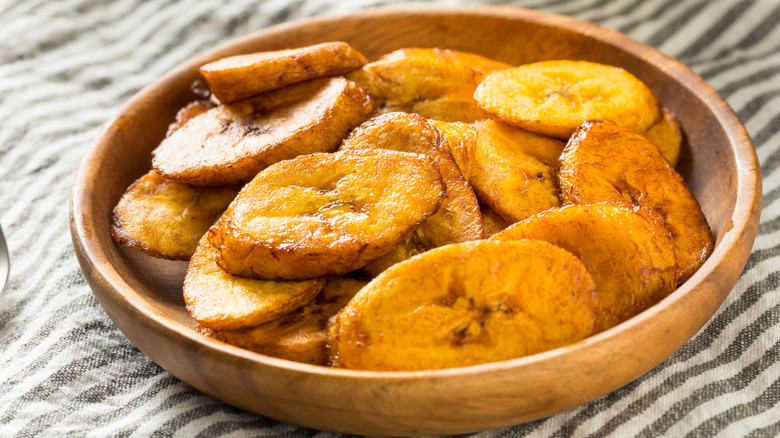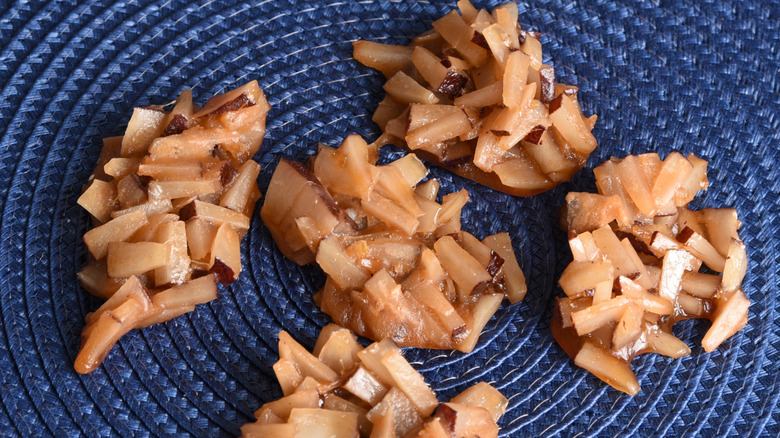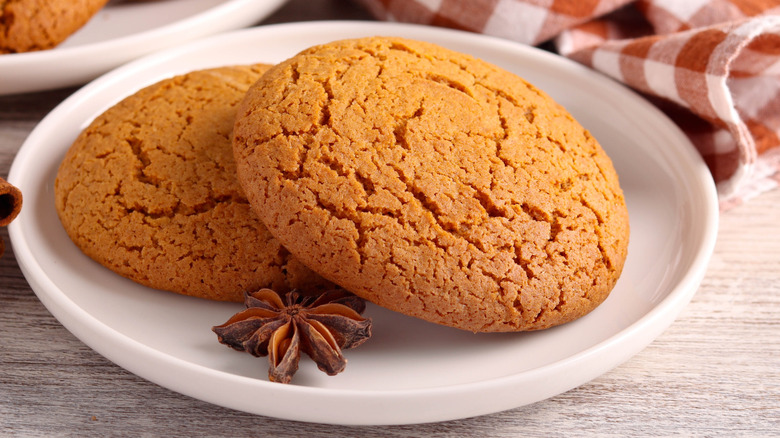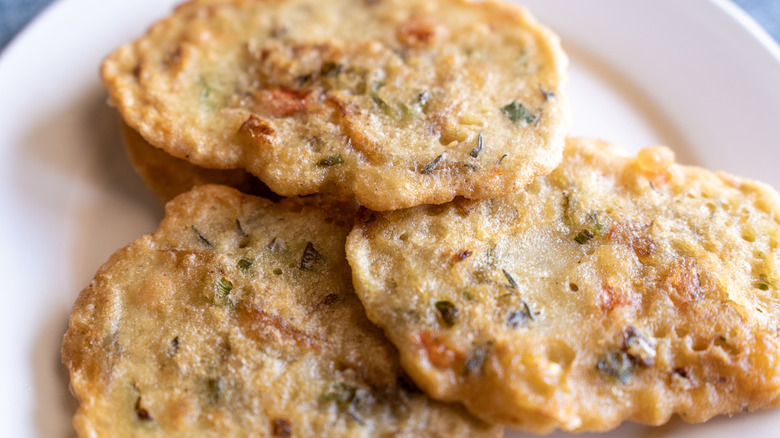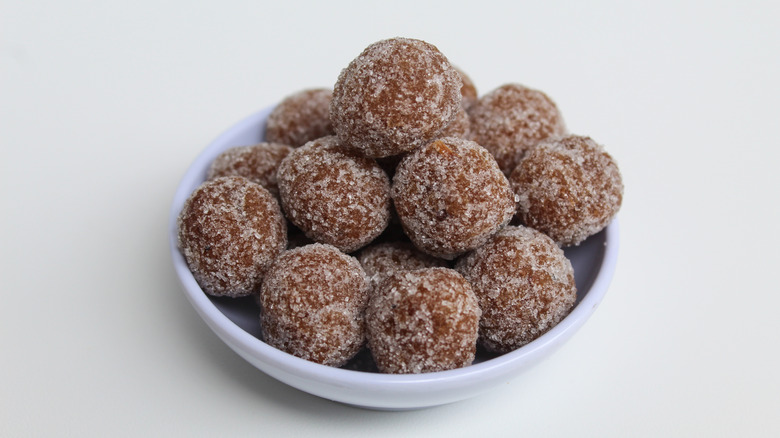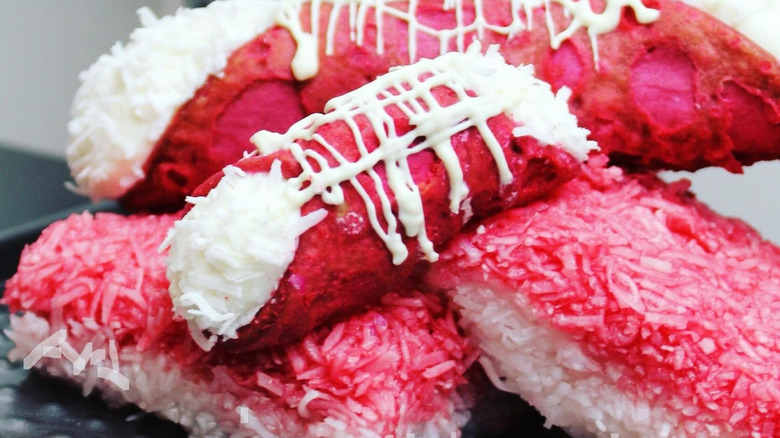14 Popular Jamaican Snacks You Need To Know
When you think of Jamaican cuisine, jerk chicken and goat curry might be two of the first dishes that come to mind. These crowd favorites are among the Jamaican dishes you have to try, however, Jamaica is a multicultural island that has much more to offer.
"Jamaican cuisine is influenced by many different cultures ...," Peter Ivey, founder of The Reggae Chefs and Mission:FoodPossible, told Tasting Table.
Indigenous Arawak, West African, Portuguese, Irish, English, Indian, and Chinese are among the cultures cooked into Jamaica's culinary tapestry, including the island's snacking culture. One example of this, Ivey notes, is the island's extensive sugar plantations and the importation of enslaved Africans gave way to several sugar-heavy snacks using leftover coconut and other creative combinations of sugar and nuts. Like these, most Jamaican snacks are intertwined with a unique story reflecting the Caribbean island's diverse roots and history. We teamed up with Ivey to come up with a list of popular Jamaican snacks you must try.
Patty
If you've ever mistook chickpea patties on the menu of a Jamaican spot for actual burgers, you'll soon learn that patties are not, in fact, burgers but an empanada-like snack that is everywhere across Jamaica. "We ... have the English pasty to thank for the ultimate Jamaican snack, the Jamaican patty," commented Peter Ivey. "Although the West African meat pie is a terrific contender for the inspiration of the meat and crust icon."
A traditional Jamaican beef patty recipe involves a flaky pastry stuffed with ground, seasoned beef. What sets a Jamaican patty apart from similar snacks like empanadas and spanakopita is its bright yellow pastry shell, which comes from turmeric and curry powders. The filling is made from ground beef, onion, Scotch bonnet pepper (another typical Jamaican ingredient), garlic, ginger, and various other spices.
This beloved snack is thought to have originated in Jamaica with the appearance of Cornish sailors who introduced the comparable Cornish pasty around the 1800s when they came to the island to trade other commodities. The Jamaican version holds its own, though, incorporating flavors of the other cultural influences on the island, such as the curried spices from India. Over the years, more inventive patty fillings have emerged. Chicken and vegetable patties are common finds, while some places, such as Jamaica's Devon House Bakery, specialize in even more niche patty varieties, such as goat curry, saltfish and ackee, and lobster, among other fillings that pay tribute to the favorite flavors of Jamaican food.
Festival
A Jamaican festival is a slightly sweet, deep-fried bread that is "uniquely Jamaican," according to Peter Ivey. The origins of Jamaican festivals can be traced back to the island's population of enslaved Africans during the 18th century. Cornmeal was a staple ingredient among the enslaved population. Some historic accounts suggest that they mixed the cornmeal with water and spices and fried it in oil, turning basic ingredients into a simple, filling food.
Today, festivals are one of the most popular snacks and street foods in Jamaica, commonly sold at street vendors, and also served as a side dish. This starchy snack is made from wheat flour, cornmeal, salt, sugar, water, and milk. The dough is fried until golden brown and crispy on the outside and light and fluffy inside. Despite its sweet flavor, a festival typically accompanies savory meals like jerk chicken and escovitch fish.
Festivals share loose similarities to plain donuts, are best enjoyed hot, and are the perfect bite to satisfy hunger on the go. Hellshire Beach in Jamaica is a great spot to sample festivals. Grab a stool at one of the brightly painted shacks, such as Aunt May's, and enjoy a festival and fried fish combination while watching the waves crash ashore.
Fried plantains
Although plantains likely originated on the Pacific island of New Guinea, plantains have been a prominent part of African cuisine for hundreds of years and were introduced to the Caribbean. Plantains were a cheap and filling food for the enslaved population, who commonly used techniques from back home to prepare them.
Today, plantains still play a starring role in Jamaica's cuisine as a well-loved snack or side dish. An important to know about plantains is that they should never be eaten raw. You can boil them, steam them, or mash them. In Jamaica, a popular way to prepare plantains is to fry them. Select ripe plantains, then peel, slice, and fry in a neutral oil until golden brown.
The result is warm, bite-size plantains that are caramelized and crispy on the outside and warm and flavorful when you bite into them. Fried plantains are a snack enjoyed any time of the day on their own or accompanying dishes like ackee and codfish for breakfast or jerk chicken and rice for dinner. Enjoy them plain, or season the plantains with salt, Cajun seasoning, or even cinnamon. Add a dash of hot sauce for a sweet and spicy combo, or serve them on top of ice cream for dessert. However they're served, this versatile Jamaican snack is a must-try.
Banana, cassava, plantain, or breadfruit chips
Like in many cultures, chips are a popular snack in Jamaica. Look twice, and you'll realize that the snack aisles are filled with more than just potato chips because Jamaica is home to many starchy fruits like bananas, plantains, and breadfruit, as well as root vegetables like cassava. Thanks to their starchy nature, these local crops are the perfect ingredients to make chips.
Peter Ivey said that while banana chips have a long history in Jamaica, these days, new varieties like cassava and breadfruit chips are coming on fast. Breadfruit is a versatile fruit that shares similarities with potatoes and is common in the South Pacific and Caribbean islands.
At grocery stores, gas stations, and street stands, bags of banana, cassava, and plantain chips are sold by brands like St. Mary's. Choose between plain, lightly salted, or other flavors like sour cream and onion and chili. Enjoy the crunchy snack on its own or with dips like guacamole or salsa.
Bun and cheese
Spiced bread, also known as Jamaican Easter spice bun, is an evolution of the British hot cross bun, which was traditionally served on Good Friday and Easter in the United Kingdom. The cross painted on the bun with flour is a literal representation of the bun's religious origins.
The English introduced hot cross buns to Jamaica during colonization. Although they have evolved from their original form, this spiced bread is still popular at Easter celebrations. Spiced bun's essence comes from a blend of aromatic spices — allspice, nutmeg, and cinnamon — mixed with molasses (another common ingredient on the island, thanks to the abundance of sugar cane plantations). Dried fruits like raisins and cherries are commonly baked into the bread.
If you're truly going to enjoy it like a local, eat your spiced bun with a slice of yellow sliced cheese on top, an addition that transforms the spiced bun into the ever-popular bun and cheese. "The combination of spiced bun and cheese is an all-island favorite that is enjoyed all year round but explodes in popularity at Easter ...," Ivey shared. "The balance of the sweet taste of the bun combined with the salt of the cheese is what drives us Jamaicans crazy!"
Peanut drops and coconut drops
An incredibly simple and tasty Jamaican treat is a peanut drop. This sweet snack is a combination of grated ginger, roasted peanuts, cinnamon, vanilla, and sugar made into a hard candy. No need to save this treat for dessert. Enjoy it any time of the day.
Peanut drops are easy to make at home. Grated ginger and roasted nuts are placed in a pot of water. Once boiling, sugar is added and left to boil for an additional 50 minutes until the liquid reduces. Cinnamon, vanilla, and any other spices, such as nutmeg, cloves, and almond extract, can be thrown in. The sticky, thickened mixture is scooped out and shaped by the spoonful on a lined pan, where the candies will cool until they are at room temperature and hardened.
Peanut drops are only one of several kinds of drops in Jamaica. Another popular variation is coconut drops, which are made from diced fresh coconut, cinnamon, ginger, vanilla, and sugar. Think of these drops like a spicy Jamaican version of a coconut macaroon.
Bulla cake
Similar to a cross between a cake and a cookie, bulla cake is made from spiced dough, in which ginger plays a leading role. Jamaicans take pride in the quality of ginger found on their island. When in Jamaica, it's common to hear its ginger referred to as the best in the world. While this assertion is debatable, the abundance of top-notch ginger has certainly found its way into many popular Jamaican recipes.
These affordable cakes are considered to be among the most popular street foods in Jamaica. Find them sold pre-packaged at most grocery stores and street stands as an easy-to-grab snack.
Bulla cakes are also easy to make fresh at home. Molasses, cinnamon, nutmeg, ginger, and allspice are mixed together to produce a thick, fragrant, eggless dough. The dough is rolled out, cut into circular shapes, and baked. While you can spread jam or butter over the cake, to truly experience bulla cakes the Jamaican way, Peter Ivey recommends that you pair these gingery, bread-like pastries with avocados (locally known as pear).
Stamp and go
Sometimes simply just called fritters, the stamp and go is a flat and fried salted codfish fritter. The unusual name is believed to come from British sailing ships in the 18th century. "Stamp and go" was an order to get something done quickly. Fittingly, stamp and gos are a popular roadside snack in Jamaica today.
This tasty fried snack is traditionally made with flaked salt cod, a fish sourced from the waters around Norway and other Scandinavian countries, but common in many of Jamaica's favorite dishes, such as Jamaica's national dish: ackee and codfish, which is a dish you might be served for breakfast in Jamaica. To make stamp and gos, the codfish is mixed into a batter with ingredients including escallion (Jamaican-grown green onion), thyme, Scotch bonnet pepper (another staple in Jamaican cooking), black pepper, and flour. The fritter is fried until its exterior is golden and perfectly crunchy and served with a spicy pepper sauce.
Stamp and gos are sold at cafes, reggae clubs, and food stands across Jamaica. At ital cafes — built on the plant-based food movement in Jamaica stemming from Rastafarian culture— it is also common to see vegetarian versions of these fritters, such as using ackee — Jamaica's national fruit that made its way over to the island from West Africa likely around the 1700s and can't be imported to the U.S. – in place of codfish.
Pepper shrimp
Peppered shrimp is a combination of some of the best flavors that Jamaica has to offer. The beloved snack is made from "a local technique of infusing Scotch bonnet peppers and other spices into shrimp," commented Peter Ivey. As you're exploring the island, you'll likely pass plenty of food stalls selling fresh produce, grilled fish, and big pots of boiled soup. Another common sight is bags filled with red shrimp — pepper shrimp, one of Jamaica's most popular street foods.
Pepper shrimp originated in the parish of St. Elizabeth in the southwest of Jamaica, where the shrimp were originally caught in the Black River next to the parish. The shrimps are marinated in a mix of spices and herbs and then stewed until cooked and aromatic. Annatto powder is an important ingredient, as it gives the dish its bright red color. Garlic, thyme, onion, allspice, and, of course, Scotch bonnet pepper are other key ingredients in pepper shrimp, a spicy, flavorful snack to enjoy from a stand while road-tripping around the island or as an appetizer.
Tamarind balls
Tamarind balls are a sweet and sour snack — and a favorite treat in Jamaica and other Caribbean cultures. Tamarind is a tropical fruit native to Africa and Asia that produces pods. The fruit has a distinct sour flavor distilled from its pods to make juice, sauces, and jams. While it might seem foreign and daunting to use initially, don't overlook tamarind and experiment with using it in different recipes. Remember, it is even a key ingredient in Pad Thai. In Jamaica, one of the most popular ways to use this fruit is to make round, sugar-coated treats known as tamarind balls that are as tarty as they are sweet.
You can find already-made tamarind balls in stores in Jamaica, which are an easy bite to pop into your mouth. However, they are also an easy treat to make at home. The most important ingredient, of course, is tamarind pulp, which can be bought in bulk or extracted fresh from tamarind pods. Sugar is mixed with the pulp until a thick dough forms. Using the dough, small balls are created by hand-rolling, and they are rolled again in granulated sugar. Enjoy them right away, or let them sit for a few hours or even overnight so the candy becomes firmer.
Gizzada
Also known as a Pinch Me Round, gizzada is a delicious Jamaican coconut tart that loosely resembles the Portuguese queijada. Its pinched, crispy pastry shell gave it its nickname "Pinch Me Round" and is filled with a sweet, dark brown coconut filling. Gizzada gets its color from the blend of spices and other ingredients.
Like many of Jamaica's dishes, gizzada's origins come with a side of history linked to the many countries that passed through the island over the centuries. Rumor has it that this coconut pastry was first introduced to Jamaica by a Portuguese Jewish community, who began arriving on the island as early as the 1500s after fleeing religious persecution back home.
Gizzadas are a wonderful blend of textures — a crunchy crust and a soft, gooey filling. Grated coconut is cooked with brown sugar, nutmeg, vanilla, and butter to create a rich filling with a touch of spice. Enjoy as a post-meal dessert or a quick sweet treat any time of the day.
Toto
Toto is a light, moist cake that incorporates the best of Jamaican flavors: coconut, allspice, ginger, nutmeg, and to truly make it Jamaican, a hint of rum. This dangerously delicious coconutty, spice-infused cake is a popular addition to family gatherings, such as a Sunday dinner.
Toto has its origins in slavery in Jamaica. As the story supposedly goes, when slaves were hungry and not given enough sustenance after hard days of work on the plantations, they mixed flour, coconut, and molasses and baked the mixture by placing hot coals on top of a metal sheet.
Today, the recipe has evolved a bit and includes a few more ingredients than the original. Nonetheless, toto remains a popular family recipe that continues to be passed down between generations. This tasty cake is a testament to the endurance and diversity of Jamaicans — and, like many of the island's favorite dishes, is a fusion of culinary traditions.
Grater cake
Also known as "sugar cake," grater cake was named after the process of grating coconut for this dessert. Less of a cake and more of a candy, this bright pink and white coconut sweet is a popular snack in Jamaica and across many of the Caribbean islands.
"My favorite Jamaican snack growing up was peanut cake and grater cake," Peter Ivey mentioned to Tasting Table. "These snacks are prevalent at street corners or intersections. Besides being sweet and crunchy, just imagine a vendor sprinting alongside a moving vehicle to collect money and give change ... What fun for a child to be a part of!"
The star ingredients in grater cake are fresh grated coconut, sugar, and water. Ginger, vanilla, almond extract, and other spices are optional add-ins to add depth to the flavor. Half of the mixture is kept plain, while the other half is turned into a bright pink hue. The pink color comes from either red food coloring or a natural coloring ingredient, such as beetroot powder. The pink and white coconut mixtures are layered on top of each other to create this simple, tasty snack that is an ode to the abundance of sugar cane plantations on the island.
Sweet potato pudding
This Jamaican favorite features grated sweet potatoes, coconut milk, and plenty of warm baking spices. The flavors share some similarities with a sweet potato casserole in the U.S., but Jamaican pudding's texture is quite different — a mixture of a dense yet moist cake-like dessert. "It's not soft and gooey like the American variety but more like a moist bread-like pastry," said Peter Ivey. He noted that cornmeal and bread pudding are other popular types of pudding.
Sweet potato pudding is a staple on Jamaican holidays. Try your hand at making pudding on your own. Modern ovens have expedited the original process of cooking sweet potato pudding, which traditionally required putting hot coals on top of and below the pan to cook it.
The first step is to grate the sweet potatoes, which is essential to ensure you get the best texture. Mix cinnamon, nutmeg, vanilla, sugar, salt, and rum into coconut milk. Gradually add the milk mixture and flour to the sweet potatoes. Lastly, stir in the butter. Pour the batter into greased baking pans, sprinkle the top with raisins, and bake until it passes the toothpick test. Enjoy with whipped cream, ice cream, or simply on its own.



